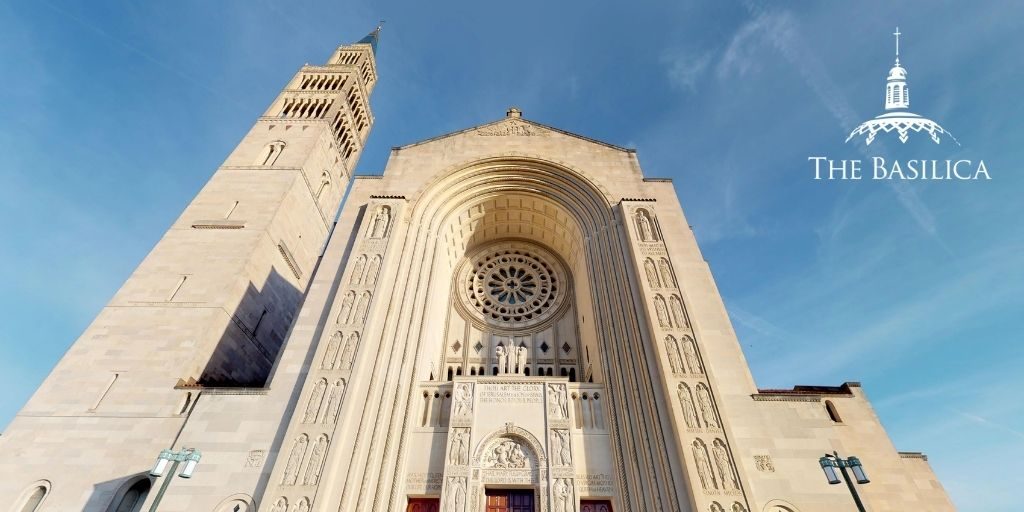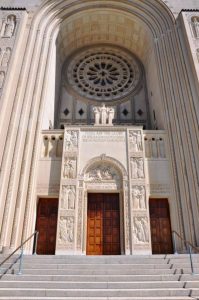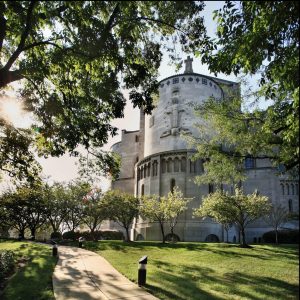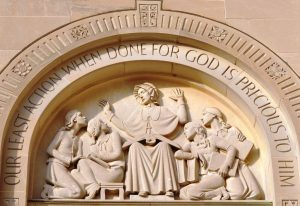
A signature element of the Basilica’s unique Byzantine-Romanesque style is the incorporation of exterior reliefs. The archways, chancels, and more are ornamented with heroic-size figures of saints and finely sculpted tympana. In today’s Guide to Art post, we invite you to explore these intricate relief carvings and what they represent.

The South Façade
Where the arch of the main entrance touches the two buttresses, carvings of the Greek letters Alpha and Omega represent God’s eternal nature. The keystone of the arch contains the ancient Celtic symbol for the Trinity, three interlocking circles called the Triquetra. At the apex of the gable is a carving of a five-pointed star and “M” with a cross at its center, representing Mary, and the surrounding eagles and laurel branches represent the consecration of the United States to her under her title of the Immaculate Conception.
Above the center door on the balcony sites is the sculpture “Mary Immaculate with Angels” by Ivan Meštrović, and below her is the text of Judith 15:9: “Thou art the glory of Jerusalem, the joy of Israel, and the honor of our people.” Directly above the door is the sculpted tympanum of the Annunciation, and flanking the doors are relief sculptures of women of the Old and New Testament: Sarah, Miriam, Ruth and Naomi, and Judith; and Elizabeth, Anna, Mary, and Martha.
Bordering the arch are various prophets and patriarchs of the Old Testament and apostles and disciples of the New Testament.

The East Façade
The relief sculptures of the East Façade are unified around the theme of faith. The clerestory level features doctors and fathers of the Church: Saints Ignatius of Antioch, Justin Martyr, Jerome, Augustine, John Chrysostom, and Leo the Great. The four niches of the east portico depict Saints Charles Borromeo, Robert Bellarmine, Thomas Aquinas, and Pope Pius X. The front of the portico features Saints Ambrose, Cyril of Alexandria, Irenaeus, and Basil the Great.
The interior of the portico features five mosaic tympana that tell the story of the Catholic faith in America. The first shows the establishment of the first parish in St. Augustine, Florida in 1565. Next depicted is the ordination of the first priest in the original thirteen states, Fr. Stephen Theodore Badin, in 1793. Then missionaries Father Eusebio Francisco Kino and Saint Junípero Serra are portrayed. In the center is Christ the Teacher.

The North Façade
The North Façade is dominated by the sculpture Mary, the Immaculate Queen of the Universe by artist Ivan Meštrović. A seven-foot limestone cross is at the gable, with “Jesus Christ the Victor” inscribed in Greek. Beneath the cross is a vase with passionflowers, representing Christ’s death and passion, vines with seven branches symbolizing the seven sacraments, and two peacocks, which stand for immortality and Christ’s resurrection. The scene is supported by Archangels Gabriel and Michael. The exterior walls of the apse feature Saints including Benedict, Teresa of Avila, Brigid of Ireland, Boniface, and Patrick.

The West Façade
The theme of the west façade is charity; it features saints of charity including Saints John Bosco, Camillus de Lellis, Vincent de Paul, Martin of Tours, Therese of Lisieux, Frances Xavier Cabrini, Francis of Assisi, and Dominic Savio. At the apex of the gable is the papal emblem of the tiara and crossed keys.
The interior tympana depict the parable of the Good Samaritan, a Sister of Charity treating the wounded on a Civil War battlefield, a military chaplain ministering to soldiers during World War II, and missionaries Father Damien and Brother Joseph Dutton serving the leper colony of Molokai.

The exterior tympana portray Pope Leo XIII sharing the encyclical Rerum Novarum and Saint Elizabeth Ann Seton teaching at Emmitsburg, while the tympanum of the west narthex shows Christ healing the paralytic.
Sources:
The Basilica Guidebook, Dr. Geraldine Rohling

